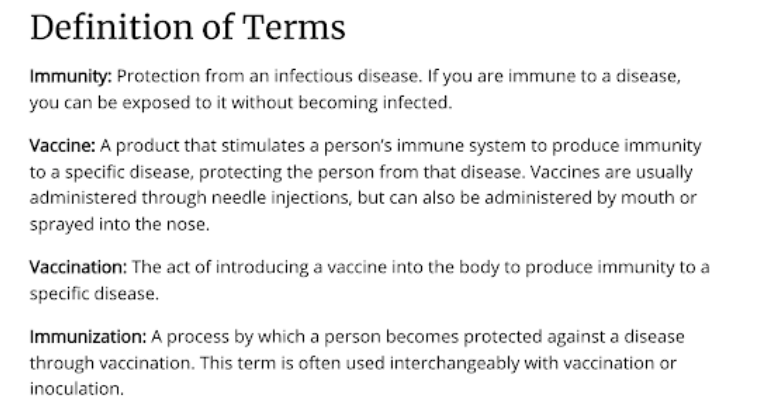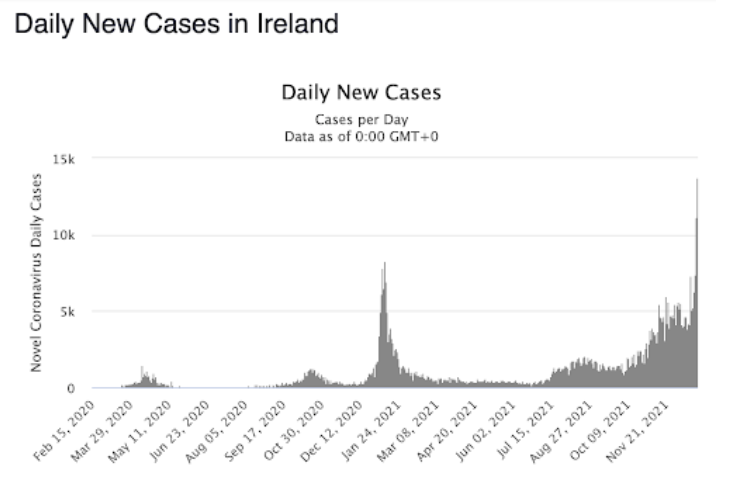What can we learn from 2021?
December 30, 2021
By Ryan M. Thomas
As the year comes to a close, I’d like to first extend my greetings to you and your loved ones during this holiday season and wish you a happy and healthy New Year.
It is common to end the year with a “look back” over the last 12 months, and with the second year of the pandemic now behind us, there’s a lot to digest.
I’d also like to be mindful that this year may have been a great struggle for some of you because of the pandemic. Some of you may have been infected or even lost loved ones to COVID. As I write about the effects of the pandemic, please know that I am sensitive to the real world struggles that the disease is causing and that it is actually what motivates me each day to advance our mission.
Looking Back at 2021
At the beginning of the year, many held onto hope that first generation vaccines would end the pandemic. This year, however, saw record cases, hospitalizations and deaths.
When the media began to first cover breakthrough infections, there was almost always a boilerplate paragraph about the effectiveness of these vaccines and how breakthrough cases were very rare.
With the emergence of Delta in the spring, many talking heads said that this wave would be the last and the pandemic would end by the fall. We were even told that this was now the pandemic of the unvaccinated.
Now, with Omicron upon us, there’s talk about how this has once again become a pandemic for all.
As I write this, breakthrough cases are soaring, but the new spin being presented is that infection by Omicron will actually protect the vaccinated against future waves and finally create “herd immunity.”
In June, we pointed to Israel to see how the rest of the world might go.
At the time, Israel was the model for an efficient and effective vaccine roll out. It was in Israel where we saw the first real-world effects of waning protection against infection. Israel quickly mobilized a third booster shot. The Delta variant was quicker to spread than Israel was able to roll out another round of booster shots. Ultimately, a heavily vaccinated Israel experienced their worst COVID Wave yet.

In August, the CDC updated the definition of a vaccine. Before the change, the definition read: “the act of introducing a vaccine into the body to produce immunity to a specific disease.”

Today, the CDC’s website defines “vaccine” as “a preparation that is used to stimulate the body’s immune response against diseases.”

So, what we’re now talking about is “protection” against a disease, instead of “immunity.”
In November, as Omicron began to spread across the world, Israel reimposed travel restrictions, restricting large gatherings again, all while mobilizing the testing of a 2nd booster shot (4th shot in total), but cases continued to rapidly increase. With the failure of the booster shot to prevent Omicron, they are now considering a pivot towards Sweden’s approach of a “mass infection” model. Their new hope is that they will be better protected with natural immunity and several booster shots against future variants.
Meanwhile, in Sweden, cases are at an all-time high. Pivoting away from the “mass infection” model, Sweden is now imposing heavy restrictions on its population.
After the spread of Delta, there was talk that in order to achieve “herd immunity”, a higher rate of vaccination would be required, now 80% or 90% of the eligible population, for life to return to normal.

Portugal and Ireland achieved those numbers.
With nearly 90% of Ireland’s population fully vaccinated, they were considered the new standard to follow in order to achieve the coveted “herd immunity” and return life back to normal. As of earlier this week, Ireland had the 4th highest infection rate in the world – behind Andorra (75% vaxxed), San Marino (80% vaxxed), and Denmark (78% vaxxed).
Portugal is also experiencing major breakthrough infections now ranking 17th for highest infection rate.
In Denmark, new data was just released showing that 79% of those infected as of December 15th were fully vaccinated, and 10% had already received a booster shot.
This isn’t just occurring in small countries, in the U.S. and U.K. daily COVID cases are 3x higher now than during previous waves.
Severe infections are less frequent because of previous infection and vaccines, but what happens if 10% of a country is sick at the same time?
How long will first generation vaccines protect against severe infection? We know that protection against infection wanes after 5-6 months, but it’s uncertain how long protection against hospitalization will last.
While the proportional rate of hospitalizations and deaths have decreased in part because of first generation vaccines, new COVID-19 variants have become much more contagious, spreading faster, infecting larger populations and as a consequence causing more deaths in 2021 compared to 2020. Early data is now indicating that Omicron is 4x more contagious than Delta – which was already one of the most contagious diseases ever seen.
As we’ve expressed in the past, sterilizing vaccines are needed to stop the spread and transmission of the disease. In the absence of sterilizing vaccines, we run the risk of putting evolutionary pressure on the virus to further mutate and perfect itself.
Insights from 2021
This has been another challenging year: hospitalizations and deaths were up, supply chains were hit hard, trust in public and health officials continued to erode, inflationary pressures caused the prices of many essential goods to rapidly increase, many countries saw greater social unrest, and Omicron hit right during the holidays causing the cancellation of many of our plans.
What can we learn from 2021?
I’d like to share a few things that I’ve shared with the Eyam Team:
- Humility: we can only live and operate in reality. As much as we yearn to return to pre-pandemic times, we’re not there yet. We need to learn to see and hear what reality is telling us, not what we want reality to tell us.
- Discernment: times are uncertain, some paradigms have changed, and as a consequence greater discernment is necessary to navigate these challenging times and make the best decisions.
- Courage: we have great responsibilities, there’s a lot to be done, and resources are almost always lacking. In order to achieve our lofty mission, we have to have courage to overcome our interior obstacles in order to sacrifice and do the right thing.
What can we learn from 2021?
December 30, 2021
By Ryan M. Thomas
As the year comes to a close, I’d like to first extend my greetings to you and your loved ones during this holiday season and wish you a happy and healthy New Year.
It is common to end the year with a “look back” over the last 12 months, and with the second year of the pandemic now behind us, there’s a lot to digest.
I’d also like to be mindful that this year may have been a great struggle for some of you because of the pandemic. Some of you may have been infected or even lost loved ones to COVID. As I write about the effects of the pandemic, please know that I am sensitive to the real world struggles that the disease is causing and that it is actually what motivates me each day to advance our mission.
Looking Back at 2021
At the beginning of the year, many held onto hope that first generation vaccines would end the pandemic. This year, however, saw record cases, hospitalizations and deaths.
When the media began to first cover breakthrough infections, there was almost always a boilerplate paragraph about the effectiveness of these vaccines and how breakthrough cases were very rare.
With the emergence of Delta in the spring, many talking heads said that this wave would be the last and the pandemic would end by the fall. We were even told that this was now the pandemic of the unvaccinated.
Now, with Omicron upon us, there’s talk about how this has once again become a pandemic for all.
As I write this, breakthrough cases are soaring, but the new spin being presented is that infection by Omicron will actually protect the vaccinated against future waves and finally create “herd immunity.”
In June, we pointed to Israel to see how the rest of the world might go.
At the time, Israel was the model for an efficient and effective vaccine roll out. It was in Israel where we saw the first real-world effects of waning protection against infection. Israel quickly mobilized a third booster shot. The Delta variant was quicker to spread than Israel was able to roll out another round of booster shots. Ultimately, a heavily vaccinated Israel experienced their worst COVID Wave yet.

In August, the CDC updated the definition of a vaccine. Before the change, the definition read: “the act of introducing a vaccine into the body to produce immunity to a specific disease.”

Today, the CDC’s website defines “vaccine” as “a preparation that is used to stimulate the body’s immune response against diseases.”

So, what we’re now talking about is “protection” against a disease, instead of “immunity.”
In November, as Omicron began to spread across the world, Israel reimposed travel restrictions, restricting large gatherings again, all while mobilizing the testing of a 2nd booster shot (4th shot in total), but cases continued to rapidly increase. With the failure of the booster shot to prevent Omicron, they are now considering a pivot towards Sweden’s approach of a “mass infection” model. Their new hope is that they will be better protected with natural immunity and several booster shots against future variants.
Meanwhile, in Sweden, cases are at an all-time high. Pivoting away from the “mass infection” model, Sweden is now imposing heavy restrictions on its population.
After the spread of Delta, there was talk that in order to achieve “herd immunity”, a higher rate of vaccination would be required, now 80% or 90% of the eligible population, for life to return to normal.

Portugal and Ireland achieved those numbers.
With nearly 90% of Ireland’s population fully vaccinated, they were considered the new standard to follow in order to achieve the coveted “herd immunity” and return life back to normal. As of earlier this week, Ireland had the 4th highest infection rate in the world – behind Andorra (75% vaxxed), San Marino (80% vaxxed), and Denmark (78% vaxxed).
Portugal is also experiencing major breakthrough infections now ranking 17th for highest infection rate.
In Denmark, new data was just released showing that 79% of those infected as of December 15th were fully vaccinated, and 10% had already received a booster shot.
This isn’t just occurring in small countries, in the U.S. and U.K. daily COVID cases are 3x higher now than during previous waves.
Severe infections are less frequent because of previous infection and vaccines, but what happens if 10% of a country is sick at the same time?
How long will first generation vaccines protect against severe infection? We know that protection against infection wanes after 5-6 months, but it’s uncertain how long protection against hospitalization will last.
While the proportional rate of hospitalizations and deaths have decreased in part because of first generation vaccines, new COVID-19 variants have become much more contagious, spreading faster, infecting larger populations and as a consequence causing more deaths in 2021 compared to 2020. Early data is now indicating that Omicron is 4x more contagious than Delta – which was already one of the most contagious diseases ever seen.
As we’ve expressed in the past, sterilizing vaccines are needed to stop the spread and transmission of the disease. In the absence of sterilizing vaccines, we run the risk of putting evolutionary pressure on the virus to further mutate and perfect itself.
Insights from 2021
This has been another challenging year: hospitalizations and deaths were up, supply chains were hit hard, trust in public and health officials continued to erode, inflationary pressures caused the prices of many essential goods to rapidly increase, many countries saw greater social unrest, and Omicron hit right during the holidays causing the cancellation of many of our plans.
What can we learn from 2021?
I’d like to share a few things that I’ve shared with the Eyam Team:
- Humility: we can only live and operate in reality. As much as we yearn to return to pre-pandemic times, we’re not there yet. We need to learn to see and hear what reality is telling us, not what we want reality to tell us.
- Discernment: times are uncertain, some paradigms have changed, and as a consequence greater discernment is necessary to navigate these challenging times and make the best decisions.
- Courage: we have great responsibilities, there’s a lot to be done, and resources are almost always lacking. In order to achieve our lofty mission, we have to have courage to overcome our interior obstacles in order to sacrifice and do the right thing.






